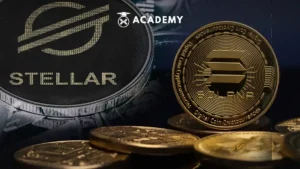Ever been confused when choosing between Solana and Stellar? Many crypto investors have experienced the same thing.
While they may seem similar at first glance, Solana and Stellar are actually built on very different foundations, visions, and technological approaches.
This article will help you clearly understand these differences so you can choose the option that best suits your investment needs.
Vision & Philosophy: Blockchain for Whom and for What?

Before assessing the technical aspects and potential benefits, it’s important to first understand the primary missions of Solana and Stellar, as they were built for very different purposes.
Solana is designed for speed and scalability. With a combination of Proof of History and Proof of Stake, Solana can handle thousands of transactions per second at very low fees.
Its focus is clear: supporting smart contracts, Web3 applications, DeFi, NFTs, and blockchain gaming. Its ecosystem is growing rapidly and attracting many developers.
In contrast, Stellar focuses on financial inclusion. Its goal is to facilitate cross-border payments with low costs and broad access, especially for the unbanked.
Using a federated consensus model, Stellar offers high transaction speeds and system stability that is proven to be resistant to disruptions.
Solana is well-suited for technological innovation and dApp development. Stellar is more appropriate for affordable and accessible financial solutions. In this case, the choice comes down to your needs: Web3 innovation or a social mission.
Core Technology: Fast vs. Stable
When it comes to technology, Solana and Stellar take two different approaches.
Solana focuses on extreme performance with a combination of Proof of Stake and Proof of History, theoretically capable of processing up to 65,000 transactions per second. Features like Sealevel and Gulf Stream further boost its efficiency.
In contrast, Stellar prioritizes long-term stability through the Stellar Consensus Protocol (SCP), which relies on a network of trusted validators.
Despite only handling around 1,000 transactions per second, Stellar hasn’t experienced any downtime since 2014, an impressive track record.
Solana excels in decentralization, block time, and transaction volume, but has a history of network outages. On the other hand, Stellar is slower but more stable, with instant finality and robust governance.
For active users of DeFi, NFTs, or those needing fast transactions, Solana is an attractive option. However, for stable and proven cross-border remittances and payments, Stellar remains a solid option.
Transaction Fees & Efficiency
Both are known for their low transaction fees, but there are striking differences when you look more closely.
Solana charges an average of around 0.00025 SOL per transaction, which is already significantly lower than Ethereum or BNB Chain, thanks to its combination of PoH and PoS, resulting in high throughput.
However, Stellar is even more efficient. Its fees are only around 0.00001 XLM per transaction, making it one of the most economical in the crypto space. This efficiency makes it ideal for microtransactions and cross-border remittances.
If you’re active in the world of DeFi, NFTs, or Web3 applications, Solana could be a superior choice due to its speed, affordability, and extensive ecosystem.
However, if you’re more focused on remittances, community wallet management, or need a lightweight, stable payment system, Stellar is a better fit.
Tokenomics & Token Function (SOL vs. XLM)
The SOL token on the Solana network has three main roles: as a means of paying transaction fees (gas fees), a staking instrument to maintain network security, and a component in the governance mechanism, despite its off-chain nature.
This mechanism allows SOL holders to earn passive rewards, which can reach up to 7% APY.
Meanwhile, XLM is used primarily to pay transaction fees and acts as a liquidity bridge between currencies in cross-border payment systems.
While it lacks competitive staking features like Solana, XLM still offers a small yield and is a key foundation of the Stellar ecosystem, which focuses on global financial inclusion.
In terms of market performance, SOL has a significantly higher market capitalization and daily transaction volume than XLM, making it more attractive to investors seeking long-term growth.
However, XLM remains relevant for users who prioritize efficiency, stability, and accessibility in the context of digital finance.
So, what is the potential of both as investment assets? The answer depends on your goals.
SOL is for aggressive growth and active participation in the Web3 ecosystem, while XLM is suitable for those seeking exposure to crypto with a more conservative approach and utility in the cross-border financial sector.
Ecosystem & Featured Projects
Solana has built a strong reputation in the Web3 space with a rich and innovative ecosystem.
Solana boasts several flagship projects, including Phantom, an easy-to-use crypto wallet, and Magic Eden, the largest NFT marketplace on its network.
Stepn, a Move-to-Earn app that combines physical activity with crypto incentives, Jupiter, a DEX aggregator, and Raydium, which offers AMM and order book features, are also among them.
The presence of these projects demonstrates Solana’s broad reach and potential utility within the growing Web3 ecosystem.
Meanwhile, Stellar is focusing more on collaborations with the traditional financial sector.
Some of its strategic partners include MoneyGram for remittance services, Circle as the issuer of USDC on the Stellar network, and IBM in the development of a global payment system.
Support for CBDC projects in various countries further emphasizes Stellar’s role as a blockchain infrastructure that promotes inclusion and modernization of the global financial system.
The striking difference between the two lies in the direction of ecosystem development: Solana is driving the digital revolution through Web3, while Stellar is more focused on evolving the traditional financial system to make it more efficient and open.
Market Statistics: Volume, Holders, Market Cap (Updated 2025)
Throughout 2025, Solana and Stellar exhibited contrasting market dynamics, both in terms of price, daily volume, and capitalization dominance.
According to bitgetapp.com, as of August 4, 2025, the price of 1 SOL was around IDR 2,660,000, with a market capitalization of IDR 1,429,000,000,0000 and a daily volume of IDR 66,440,000,000,000.
In contrast, citing godex.io, XLM is trading at IDR 6,733 with a market cap of around IDR 210,000,000,000 and a daily volume of IDR 8,820,000,000,000, which is significantly smaller than Solana.
In terms of volume dominance, SOL remains a favorite among active traders, with a higher volume-to-market cap ratio.
The price ratio between SOL and XLM also shows a wide gap, with 1 SOL equivalent to approximately 395 XLM according to the latest price conversion.
Data from Bitget and Godex also notes that Solana has more consistently recorded medium-term gains than the volatile XLM, but has yet to demonstrate a solid long-term recovery trend.
With Solana’s quarterly price performance rising by more than 12%, coupled with consistently high volume, SOL appears to be more likely to experience consistent growth throughout 2025.
Meanwhile, while XLM has occasionally recorded daily spikes, its long-term trend has not shown any signs of significant accumulation by institutional or retail investors.
Developer Community & Activity
In the crypto world, developer communities and activity play a crucial role in driving adoption and innovation.
Solana has emerged as a highly technically active ecosystem, with high GitHub contributions and the hosting of numerous global hackathons.
Furthermore, Solana also provides a variety of developer tools that support the rapid and efficient development of decentralized applications, making it a fertile ground for Web3 developers.
Stellar, on the other hand, has a different approach, building a leaner community oriented toward institutional collaboration.
The support of major entities such as IBM, MoneyGram, and Circle has led to development on Stellar focusing on financial system efficiency and cross-border integration.
While not as large-scale as Solana, the Stellar community continues to actively contribute to building inclusive and applicable blockchain solutions for the traditional sector.
Network Risk & Stability
In terms of network risk and stability, Solana and Stellar exhibit stark contrasts.
Solana, while known as a high-performance blockchain, has a history of experiencing downtime due to traffic spikes and technical complexity.
However, the development team has responded to this by launching Firedancer, a node client upgrade designed to drastically improve network stability and availability.
This makes it more resilient to future high transaction loads. Meanwhile, Stellar has offered consistent network stability since its inception.
Using a simpler and more focused federative consensus model, Stellar rarely experiences major outages, making it a reliable choice for financial applications that require continuity.
In terms of risk assessment, Solana may have greater technical risks due to its complex architecture, but it also shows concrete steps towards improvement.
Stellar, on the other hand, is more conservative yet stable, making it a solid foundation for cross-border financial applications.
Which One is Right for You?

If you’re choosing between Solana and Stellar, the best choice largely depends on your needs and user profile.
For beginners in crypto or looking to use digital assets for cross-border financial transactions, Stellar is a more user-friendly and stable option.
This network is designed to simplify access to financial services, with an easy-to-understand structure and very low transaction fees.
This makes it suitable for more conservative users or those focused on efficient remittances.
However, if you’re an active Web3 user, a decentralized application (dApp) builder, an NFT trader, or an aggressive investor seeking potential profits from market volatility, Solana may be a more attractive ecosystem.
Solana offers high speeds, massive transaction capacity, and support for smart contracts and a variety of blockchain-based DeFi and gaming applications.
While Solana carries higher technical risks, technological advancements like Firedancer make it increasingly mature to handle large-scale needs.
Thus, Solana and Stellar serve different user segments, and the best decision depends on your investment style and goals in crypto.
Reflective Conclusion: A Combination or a Choice?
So, that was an interesting discussion about Solana or Stellar. Here’s What You Should Know Before Buying, which you can read in full at the INDODAX Academy Crypto Academy.
In conclusion, you don’t always have to choose between Solana and Stellar, as both can complement each other in your portfolio.
SOL can be an option for those seeking high growth potential in the Web3 sector, while XLM can be a balancing asset with stability and a focus on financial inclusion.
Most importantly, avoid making decisions based on hype. First, understand the utility of each asset and how it relates to your own investment strategy.
If you’re interested in trying both, Solana (SOL to IDR) and Stellar (XLM to IDR) are available and can be purchased directly on the Indodax market.
By the way, besides broadening your investment horizons, you can also stay updated with the latest crypto news and monitor digital asset price movements directly on the INDODAX Market. For a more personalized trading experience, explore our OTC trading service at INDODAX. Don’t forget to activate notifications to stay up-to-date with the latest information about digital assets, blockchain technology, and various other trading opportunities, only at INDODAX Academy.
You can also follow our latest news on Google News for faster and more reliable access to information. For an easy and secure trading experience, download the best crypto app from INDODAX on the App Store or Google Play Store.
Maximize your crypto assets with the INDODAX Earn feature, a practical way to earn passive income from your holdings.
Also follow our social media here: Instagram, X, Youtube & Telegram
FAQ
1.Is Solana suitable for beginners?
Technically, Solana does have advanced features and high speed, but its interface can feel complex for beginners.
If you’re new to crypto, learning with simpler assets like Stellar might be a more comfortable starting point. However, if you want to jump right into the Web3 ecosystem like NFTs and DeFi, Solana is still worth a try.
2.Why is Stellar often used for international money transfers?
Stellar is specifically designed for efficient cross-border payments. Its transaction fees are very low and the process is fast, even eliminating the need to rely on banks.
Stellar also partners with companies like MoneyGram and Circle to bridge crypto and fiat for global money transfers.
3.Can Solana and Stellar be stored in a personal wallet?
Yes. You can store Solana in wallets like Phantom, Solflare, or Ledger. Stellar is supported by wallets like Lobstr, Solar Wallet, and Ledger.
Be sure to write down your seed phrase and avoid storing it in public or online.
4.Which is safer for the long term: SOL or XLM?
Both have their own advantages and risks. SOL has great potential due to its active Web3 ecosystem, but has experienced downtime.
Stellar is more stable and secure for long-term storage because its network rarely experiences disruptions. So, the decision depends on your risk profile.
5.Solana vs. Stellar: Which is more profitable for investment?
If you’re looking for rapid growth and are prepared to withstand high fluctuations, Solana could be more profitable.
But if you want exposure to projects that focus on payment efficiency and stability, Stellar could be an option. Many investors even choose to hold both for diversification.
6.How do I buy Solana and Stellar on Indodax?
It’s easy! Simply register an account on Indodax, verify your account, and deposit funds. After that, search for SOL or XLM assets on the Indodax Market, then purchase the desired amount.
Author: Boy






 Polkadot 9.00%
Polkadot 9.00%
 BNB 0.51%
BNB 0.51%
 Solana 4.77%
Solana 4.77%
 Ethereum 2.37%
Ethereum 2.37%
 Cardano 1.58%
Cardano 1.58%
 Polygon Ecosystem Token 2.11%
Polygon Ecosystem Token 2.11%
 Tron 2.85%
Tron 2.85%
 Market
Market


